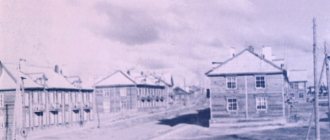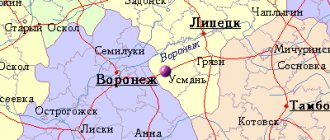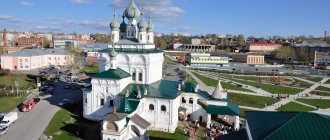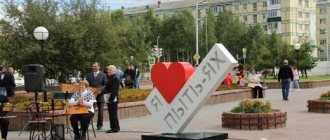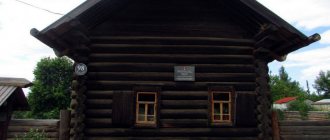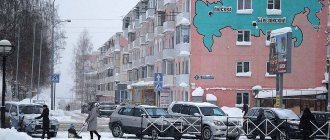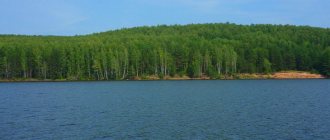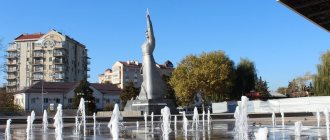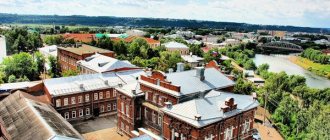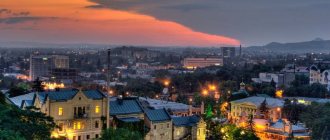Osa city
Quiet, cozy, calm. There are unusually few people and transport on the streets. The air is somehow different compared to the metropolis. I am sure that many who were born here and then left have returned to their homeland more than once.
The population of Osa is about 21 thousand. The telephone code is +7 342-91. Distance 142 kilometers along the highway southwest of Perm. The city is washed on three sides by rivers, including the Kama.
Church of the Kazan Icon of the Mother of God
The Kazan Church was built at the end of the 19th century on the site of a wooden cemetery church. The architecture of the temple is dominated by the spirit of eclecticism. The church is single-altared, crowned with five decorative domes and a multi-tiered bell tower under the original onion dome.
In the 30s In the 20th century, the church was closed, but in 1944 it was reopened for services, and it was the only operating church in the Osinsky region. In the 1990s, restoration work was carried out on the church, and in 2007 the main dome was repaired. Currently, the Kazan Church has been given the status of an architectural monument of regional significance.
Location: Yuzhnaya street - 4.
Coat of arms
In the 1780s, Osa became a city, and it became necessary to create a coat of arms. Officials proposed placing a hive with flying bees in the lower part.
The idea arose because Bashkirs lived around the city and were engaged in beekeeping. The Metropolitan Commission on Heraldry made adjustments. The hive was placed on a tree.
Another option with wasp nests was proposed, but it did not correspond to the historical past. In 1988, a new coat of arms was approved in the form of a shield, divided by a blue Kama ribbon into green and red parts.
Later they returned to the old coat of arms - a shield divided in half. On top is a silver bear with the Gospel on the back. At the bottom is a hive on a tree.
Kul Osinsky, Rhapsody of Love
In Osa you can see many interesting sights. Merchant houses, ancient shopping arcades, and buildings of the district and voivodeship offices have been preserved here. Arriving in the historical center of this city, it is as if you are transported back to the 19th century.
Among tourists, the composition “Kul Osinsky” is of greatest interest, reminiscent of the city’s main trade in the old days. Half a century ago, matting coolies were made here; they were in great demand not only in the Perm province, but also beyond its borders. According to legend, the sculpture makes wishes come true. Vacationers often climb inside to take an original photograph.
In front of the Palace of Culture there is a landmark with the beautiful name “Rhapsody of Love”. This is a heart made of nickel tubes. Local newlyweds come here to make a wish and walk through the sculpture (then it will definitely come true). In the Palace of Culture, the Winter Garden deserves great attention.
Near the local history museum you can see a bas-relief dedicated to the Kaluzhenin brothers, who founded the city. There is also a reconstruction of part of the Osinsk fortress. From here you have a beautiful view of the Kama River. During your trip, you should also definitely visit the Valley of Waterfalls near Elovo (you can get here by car from the town of Osa in just 40 minutes).
Thus, Osa is a city that will be of interest to all inquisitive people . A holiday here will allow you to touch the wonderful moments of the history of the Fatherland.
Hymn
A marvelous city with the name Osa was born for work and for peace. And as the centuries go by, it only becomes more beautiful. Chorus: Native, beloved city! You are dear to all Aspen residents. Your minds and hands worked wonders. You are the city of our honor, You are the city of our song. We are proud of you, Beauty Osa. Neither the fire nor the history of the terrible thunderstorm broke the Wasp - Once again, from the black ashes of time, the Wasp rose like a Phoenix Bird. Chorus. The feat of battle and the feat of labor, the feat of faith and the feat of mind have always been performed by the Osinians. The country can be proud of them. Chorus. Words by V.V. Kozlov Music by S.V. Shchelkunov
Education and culture
There are two secondary specialized educational institutions in Osa: a pedagogical school and an agricultural technical school, the total number of students in them is 1513 people, the annual graduation rate is over 400 people. The pride of Osa is the Russian folk song choir, a laureate of many shows and competitions.
One example: Municipal educational institution “Secondary school No. 2 of Osa”, Perm region
The year the school was founded is 1972.
Postal address – Perm region, Osa, st. M. Gorky, 63
Phone, fax – 8(34921)2-11-66
Email addresses – sh2.os on perm-edu.ru, os_sh2 on ocpi.ru, os-sh2 on yandex.ru.
Last name, first name, patronymic of the head is Nadezhda Nikolaevna Borisova. Educational Institution Awards
All-Russian – “School of the Year”, “School of the Century”
regional - “Best Schools in Russia” - 2003, 2004. Total teachers - 77;
60 teachers (78%) have higher education;
Teacher-researcher - Kobeleva E.A., Bogomyagkova L.P.
Category II: 29 people (38%);
13th category: 23 people (30%);
14th category: 16 people (21%) School participation in programs and projects
All-Russian level – “Best schools in Russia”
municipal level - project “Management of educational institutions in the context of transition to a specialized school” social:
regional level - the project of an environmental camp with a day stay for children “Create your planet” of the Committee for Environmental Protection of the Perm Region. – grant 30 thousand rubles. – head Selivanova L.A.
municipal level - Grant for social projects - 50 thousand rubles. “School basketball court” - director M.A. Sazhina Areas in which additional education is organized:
physical culture and sports - sections, therapeutic exercise, aerobics
artistic culture – music and aesthetic classes – 5 “B” class
tourism and local history - tourist rally, author's course of a teacher of the highest category F. G. Ustinova "Geography of the Osinsky region"
others - non-governmental educational institutions, electives, elective courses, elective courses, clubs, group classes School resource base
institution budget – 8,484,000 rubles.
wage fund – 6,243,000 rubles.
food costs for one student at school - 7.50 rubles. per day, 170 rub. per month
expenses for the purchase of educational and methodological literature in the past academic year - 126,120 rubles.
premises and its condition - 1,658,140 rubles. (38%) Technological equipment
number of personal computers - 42 pcs. of them:
in local networks – 30 pcs.
in global networks - 15 pcs.
library fund of the school (thousand volumes) - 52,522 tons.
sports and assembly halls – 2 sports halls and 1 assembly hall
sports grounds – 3 playgrounds; equipment for classrooms was purchased:
physics and mathematics - 150,000 rubles.
computer science - 20,000 rubles.
biology - 100,000 rub.
Famous alumni of the institution
Romanov S.I. - Head of Administration of the Osinsky District
Kotomin A.V. – Chief physician of the district
Pavlova N.V. – Head of the cultural department of the Osinsky district administration
Nefyodov A. Yu. – Deputy of the Zemstvo Assembly
Pronyushkina N. Yu. - Deputy of the Zemsky Assembly
Borisova N. N. - Principal of secondary school No. 2
Vyatkin D.V. – Deputy. head of the school administration for small business development
Grigoriev V. A. – Deputy of the City Duma
Begun V.V. - Mayor of Osa
Kobeleva E. A. – teacher-researcher (biology)
- Osinsky Vocational Pedagogical College
- Osa Gymnasium
Attractions
The Osa Local History Museum is located at: Sverdlova Street, 2. Telephone: +7 (34291) 4-70-03. Open from Tuesday to Sunday. Entrance tickets from 30 rubles.
Unfortunately, we were not able to visit there; it was a non-working day. We will definitely come here again. We walked around the neighborhood near the museum.
The first time we went in the dark to take photographs. But the entire surrounding area near the museum is not illuminated in the evening. Even with the flash, all the pictures turned out unsuccessful.
Therefore, I had to go again, but in the very morning before leaving for Perm. Instead of a museum, there used to be a Cathedral of the Assumption of the Blessed Virgin Mary, founded in 1824.
Not far from the museum is the Holy Trinity Cathedral - a project by Alexander Turchevich. It operated until 1930, after which the building was used for economic needs.
In 2004, the western part was restored. In 2006, new domes and crosses were installed. When we passed the cathedral for the first time, we saw broken glass and thought that it was abandoned.
Nearby there are obelisks dedicated to those killed in the war. Monument to the legendary IS-2 tank, a large monument to grandfather Lenin.
On the streets of Osa you can find many ancient buildings. On Lenina, 2 - Ostrog, built in 1828, used as a prison. Lenina, 4A trading gostiny dvor.
Lenina, 21 - shopping arcades, city government. Stepan Razin, 6 - mansion of the merchant Ryzhikov. At the crossroads of Lenin and Karl Marx, the mansion of the merchant Osipov, a wealthy citizen of the district.
He had stores in Perm. Lenina, 35 - city government, building built in 1870. Karl Marx, 12 - mansion of the merchant Emelin. On the corner of Karl Marx and Sverdlov there is a city four-year school.
Karl Marx, 11 - the estate of the merchant Safronov. Karl Marx, 6 - former Kuznetsov printing house. Sverdlova, 7 - women's gymnasium. On the Internationalnaya, the estate of the Cherdyntsev merchants.
In Perm they had a malt and brewery. International, 6 - zemstvo primary school. Sovetskaya, 32 - zemstvo council.
At 71 Maxim Gorky Street there is a local cultural center “Neftyanik”. Where cultural events and fairs are held. Various sections, clubs, show ballet “Helios”.
Behind the palace there is a fairground where various holidays are held - City Day, New Year and others. In winter, there is an ice skating rink for children.
Interesting museums
The clock museum has been operating in the city for a short time; it was opened in 2015 with money from a local native. The collection includes about 200 items from the 19th and 20th centuries, and is constantly being updated with new exhibits.
Since the mid-20th century, the building of the Assumption Cathedral has housed a local history museum. During the reconstruction of the church it had to be moved. Since 1987, the museum has again functioned in the building of the former temple. On the excursion you can see a variety of historical values:
- paintings;
- coins;
- watch.
There is also a huge exhibition dedicated to Bereng. The main exhibit is a diorama called “The Capture of the Osa Fortress by Pugachev”, the size of which is 160 square meters.
The nature museum showcases the richness of the city's flora and fauna. The exhibition includes more than 300 species of animals, plants and minerals. The unique “Osinsky Globe” is located here, clearly showing the geographical connections of the Perm Territory with literally the entire planet.
It is recommended to pay special attention to the diorama “Nature of the Osinsky Kama Region”. It is divided into 4 parts, each of which illustrates one of the seasons. The museum also displays a herbarium of plants and an interesting collection of stuffed animals.
Origin of the name Osa
There are several versions:
- According to one of them, the city got its name thanks to an insect. Collecting honey was the main industry of the local residents.
- According to another, the name appeared due to Pugachev’s attack. The town is small and bites like a wasp. However, the city received its name long before the capture of the fortress by Pugachev.
- The third version is that the city of Osa is based on the ancient settlement of the Khante (Ostyaks).
- The fourth is named after the Osinka river. From the Vogul language it means “grayling fish”.
- Fifth - 700-800 years ago, on the site of Osa there was an ancient Arab settlement, serving as a stopover in the middle of the route from Bulgaria (Kazan) to Cherdyn. Middle from Arabic "osat un".
Holy Trinity Cathedral
This temple is the symbol of the city of Osa. The church was built several years before the February Revolution of 1917 in the Russian-Byzantine style. The temple is very large - 44 meters high, it is the second largest in the Perm diocese.
The building is decorated with amazing red brick patterns; inside there are three iconostases, icons for which were painted by famous Moscow painters.
During the years of Soviet power, the temple housed a local history museum, tractor workshops, an ice storage warehouse, a gym, and a bus station. Only in 2004 the temple was re-consecrated, and it began to fulfill its religious purpose. Currently, the temple is crowned with a four-meter cross and four domes with crosses. In good weather, thanks to its favorable location, the cathedral can be seen from many kilometers away.
Location: Stepan Razin street - 2.
References[edit]
Notes
- ^ a b c d e
Law #416-67 - ^ a b c
Russian Federal State Statistics Service (2011). All-Russian population census 2010. Volume 1. All-Russian Population Census 2010 (in Russian). Federal State Statistics Service. - "26. The size of the permanent population of the Russian Federation by municipalities as of January 1, 2022.” Federal State Statistics Service. Retrieved January 23, 2022.
- ^ a b c d e
Law #1717-348 - "On the calculation of time." Official Internet portal of legal information
(in Russian). June 3, 2011. Retrieved January 19, 2022. - Post office. Information and computing center of OASU RPO. ( Russian Post
).
Postal Objects Search (
in Russian) - All-Union Population Census of 1979. National composition of the population by regions of Russia (XLS). All-Union Population Census of 1979 (in Russian). 1979 – via Demoscope Weekly
(website of the Institute of Demographics of the State University—Higher School of Economics. - All-Union Population Census of 1989. The actual population of union and autonomous republics, autonomous regions and districts, territories, regions, districts, urban settlements and village-district centers. All-Union Population Census of 1989 (in Russian). Institute of Demography of the National Research University: Higher School of Economics. 1989 – via Demoscope Weekly
. - Russian Federal State Statistics Service (May 21, 2004). The population of Russia, constituent entities of the Russian Federation as part of federal districts, districts, urban settlements, rural settlements - regional centers and rural settlements with a population of 3 thousand or more people (XLS). All-Russian Population Census 2002 (in Russian).
Municipal-territorial structure
| № | Municipality | Administrative center | Number of settlements | Population | Area, km2 |
| 1 | Osinsky urban settlement | Osa city | 6 | 21 732 | 105,68 |
| 2 | Verkhnedavydovskoye rural settlement | Verkhnyaya Davydovka village | 9 | 684 | 245,33 |
| 3 | Gorskoe rural settlement | village of Gory | 6 | →638 | 239,64 |
| 4 | Gremyachinskoe rural settlement | Gremyacha village | 14 | 1010 | 291,75 |
| 5 | Komarovskoye rural settlement | village Komarovo | 7 | 774 | 155,48 |
| 6 | Krylovskoe rural settlement | village of Krylovo | 7 | 1661 | 269,15 |
| 7 | Novozalesnovskoe rural settlement | village of Novozalesnovo | 5 | 632 | 206,94 |
| 8 | Paklinskoe rural settlement | Pakli village | 11 | 1037 | 201,47 |
| 9 | Palskoe rural settlement | village of Pal | 10 | 618 | 341,95 |
Economy
- The basis of the region's economy is industry, construction, paid services and trade.
- In the industrial structure, the leading role remains with the fuel and energy complex. There is a machine-building plant in the area that produces pumps and shut-off valves. The timber industry complex harvests and exports about 100 thousand m³ of wood per year. The purchase of raw materials for these enterprises is carried out mainly from agricultural producers in the region. On average, the region produces about 60 tons of sausages and about 200 tons of semi-finished meat products per year. In addition, in the area there is a JSC "Khleb", which produces bakery, pasta, confectionery products, and a workshop for the production of confectionery products on the basis of a former brewery.
- The agricultural sector of the district employs 13 commodity producers. Every year the region produces about 6 thousand tons of milk, about 500 tons of meat, the gross grain harvest is 6.5 thousand tons; 3.4 thousand tons of potatoes.
- In the field of construction and paid services, the main share belongs to the structures of the oil industry - LLC BC "Eurasia", LLC "Service", LLC "Osinskoye UTT", as well as housing and communal services enterprises.
- Since 2005, the area has been subsidized.
- Tchaikovsky city, Perm region - travel on the map
- Suksun, Perm region (sights and significant places)
A new round of development
The population of the city by that time was 8.5 thousand people.
In the second half of the 20th century, a new milestone for our city opened, which gave a significant impetus to the development and improvement of the living conditions and activities of the Osinsky people.
So in the 1960s, along with the developing oil industry of the Soviet Union, the city of Osa began the construction of wells and oil production in the areas and fields of the Osinsky district.
This has certainly opened up new opportunities in terms of housing construction, increasing jobs in connection with construction and commissioning
- machine-building plant,
- brewery and dairy,
- opening of bakeries,
- meat processing plant,
which provided their products not only to the region, but also to the Perm region.
By the way, Osinsky district
was formed in 1924, and before that from 1781 to 1923. The administrative-territorial unit of the Perm province of the Russian Empire and the RSFSR was Osinsky district with the center of the district city of Osa.
The coat of arms was also assigned by Decree of the Empress of All-Russia Catherine II of July 17, 1783.
Map
| Wasp: cards |
Wasp: photo from space (Google Maps) Wasp: photo from space (Microsoft Virtual Earth)
| Wasp. Nearest cities. Distances in km. on the map (in brackets along roads) + direction. Using the hyperlink in the distance , you can get the route (information courtesy of the AutoTransInfo website) | |||
| 1 | Frequent | 28 (219) | Z |
| 2 | Barda | 40 (39) | YU |
| 3 | Yelovo | 41 (51) | SW |
| 4 | Yugo-Kama | 47 (84) | WITH |
| 5 | Okhansk | 48 (99) | WITH |
| 6 | Bolshaya Sosnova | 66 (155) | NW |
| 7 | Star | 71 (175) | NE |
| 8 | Nytva | 72 (146) | WITH |
| 9 | Kultaevo | 73 () | NE |
| 10 | Kukushtan | 73 (95) | NE |
| 11 | Ural | 74 (159) | WITH |
| 12 | Gamovo | 75 () | NE |
| 13 | Wow | 79 (156) | NW |
| 14 | Uinskoe | 81 (123) | SE |
| 15 | Kondratovo | 86 () | NE |
| 16 | Horde | 88 (158) | IN |
| 17 | Kungur | 90 (136) | IN |
| 18 | Krasnokamsk | 90 (172) | WITH |
| 19 | Votkinsk | 91 (168) | Z |
| 20 | May | 91 (182) | WITH |
| 21 | Overyats | 92 () | WITH |
| 22 | Permian | 92 (135) | NE |
| 23 | Chernushka | 95 (109) | SE |
| 24 | Queda | 95 (136) | YU |
| 25 | Sharkan (Udmurt Republic) | 95 (197) | Z |
| 26 | Chaikovsky | 97 (131) | SW |
| 27 | Vereshchagino | 99 (179) | NW |
| 28 | Novy (Udmurt Republic) | 100 () | SW |
| 29 | Debyosy (Udmurt Republic) | 106 (211) | NW |
| 30 | Ust-Kishert | 107 (172) | IN |
a brief description of
The city is located in the Middle Urals, on the left bank of the Kama, near the confluence of the river. Tulva, 110 km southwest of the railway. Chernushka station, 146 km southwest of Perm. Pier on the Votkinsk Reservoir.
Territory (sq. km): 105
Historical sketch
Founded in 1591 (1596 ???) as the Novonikolskaya settlement on the Osinsky settlement. Later - a fortress to protect the eastern borders of the Russian state.
The name of the settlement is after the Church of St. Nicholas the Wonderworker, the settlement is named after the river. Wasp. The origin of the hydronym has not been established; the proposed explanations were unsatisfactory. The connection with the name of the insect wasp is purely external.
In a document of 1623, the village is mentioned as Osinskaya Nikolskaya Sloboda, in 1678 Osinskaya Sloboda, in 1732 the village of Osa, in 1708-19. and from 1739 the city of Osa.
Under Peter I, the fortress was surrounded by new double walls with a high steep roof, 5 towers were built, and lifting gates were built on the eastern side.
In the 18th century The Siberian Highway passed through Osa.
In 1774, Osa was taken by the troops of E. Pugachev (the capture of the city was described by V.Ya. Shishkov in the epic “Emelyan Pugachev”).
In 1708 it was assigned to the Kazan province, from 1719 in the Kazan province (in 1737-44 in the Ufa province). Since 1781 - a county town in the Perm region of the Perm governorship, since 1796 - in the Perm province.
From the beginning of the 19th century. center for trade in agricultural products. The main occupations of the residents were the production of matting, sacks, ropes, and work on the pier.
In 1856, in the district town of Osa, Perm province, there were 2 churches, 288 houses, 39 shops.
In 1846, the first school appeared in Osa, in 1870 a zemstvo hospital was opened, and in 1872 a telegraph was established from Perm.
Economy
Machine-building plant. Forestry and food industry enterprises.
In the Osinsky region - oil production (since 1963).
Main enterprises
Culture, science, education
Museum-diorama “The Peasant War of 1773-75 under the leadership of Pugachev.”
Organic chemist A.A. was born in Osa. Korotkov.
Museums, galleries, exhibition halls
Osinsky Museum of Local Lorehttps://www.museumperm.ru/
Architecture, sights
Assumption Cathedral (1790-1800; classicism), mosque (mid-19th century) Trinity Cathedral (1902-16; pseudo-Russian style).
The buildings of the voivodeship and district offices (both 1800-02), government offices (1800-28) and Gostiny Dvor (first half of the 19th century), the former house of Ivanov (wooden, first half of the 19th century), Safronov, Cherdyntsev, Osipov (all – mid-19th century), etc.
| Population by year (thousands of inhabitants) | |||||||
| 1856 | 1.3 | 1979 | 20.0 | 2005 | 23.0 | 2014 | 21.0 |
| 1897 | 5.1 | 1989 | 24.1 | 2006 | 22.8 | 2015 | 21.2 |
| 1913 | 5.8 | 1992 | 25.4 | 2007 | 22.6 | 2016 | 21.1 |
| 1926 | 5.9 | 1996 | 26.6 | 2008 | 22.5 | 2017 | 21.1 |
| 1931 | 6.3 | 1998 | 26.5 | 2010 | 22.4 | 2018 | 21.1 |
| 1939 | 9.2 | 2000 | 26.5 | 2011 | 21.2 | 2019 | 20.9 |
| 1959 | 12.7 | 2001 | 26.5 | 2012 | 21.1 | 2020 | 20.8 |
| 1970 | 15.0 | 2003 | 23.5 | 2013 | 21.0 | 2021 | 20.8 |
Literature
- Pospelov E.M.
Geographical names of the world: Toponymic dictionary: About 5000 units. M.: Russian dictionaries, Astrel Publishing House LLC, AST Publishing House LLC, 2001. p. 314 - Ch.
ed. Gorkin A.P. Geography of Russia: encyclopedic dictionary. M.: Great Russian Encyclopedia, 1998. pp. 432-433 - Ch.
ed. Lappo G.M. Cities of Russia: encyclopedia. M.: Great Russian Encyclopedia, 1994. pp. 336-337

